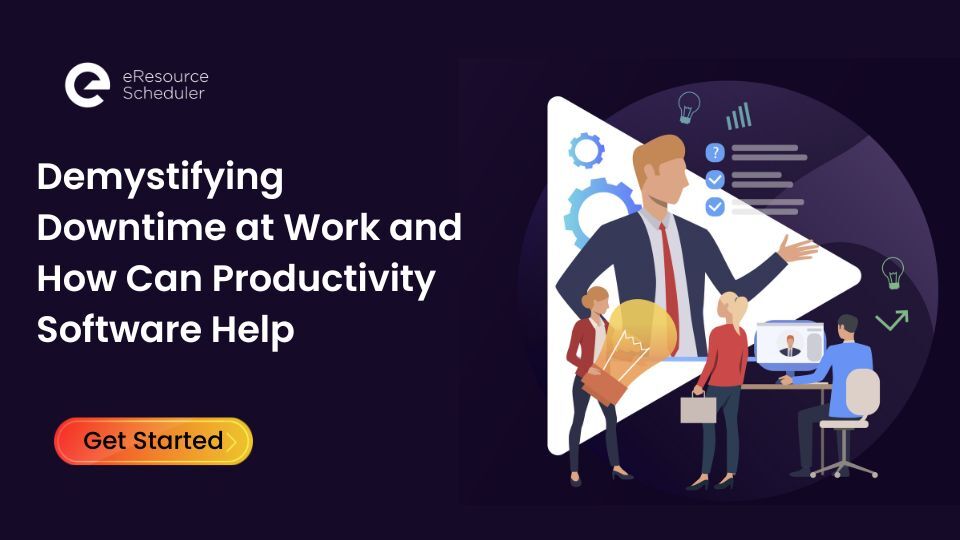
In the relentless pursuit of better productivity, downtime at work often raises concerns. But the key question is: Is it an unproductive lull or a crucial pause for rejuvenation? This blog explores the nuanced world of downtime at work, dissecting its advantages and drawbacks. From fostering creativity to the potential pitfalls of lost momentum, we'll navigate the fine line between optimal rest and unproductive idleness. By the end, you'll have a comprehensive understanding of how to harness downtime as a powerful tool in your workplace. Read on to uncover how to create a delicate balance between work and well-deserved breaks to foster better productivity with the help of productivity software.
Downtime at work refers to periods when employees find themselves without assigned tasks, often due to circumstances beyond their control. It can arise from unforeseen events like equipment breakdowns or power interruptions in a production environment. However, downtime might result from inadequate or inaccurate task allocation or inaccurate scheduling too. In businesses with seasonal cycles, planned downtime is a routine occurrence. Whether anticipated or unplanned, knowing how to navigate downtime is crucial for sustaining resource productivity.
Scheduled intervals during which employees are not anticipated to be actively engaged in work are termed planned downtime. This aspect should be factored in when allocating resources and it includes various scenarios such as the following:
Unplanned downtime can pose challenges, depending on how managers address it. Consider the following instances:
Both remote and in-office employees often struggle to allocate themselves ample breaks. Let’s see what the repercussions of this blurring of boundaries are .
Merely being highly productive does not ensure the quality of the output. Efficiency, the act of accomplishing numerous tasks swiftly, is frequently confused with efficacy, which emphasizes completing tasks to a commendable standard. This means that a team might appear exceptionally productive, yet the results they yield may be subpar. If this resonates with your organization, it could signal an issue of overutilization.
Overutilization occurs when employees are assigned workloads surpassing their capacities, leading to overwork, neglect of breaks, and overtime.This often arises due to inadequate planning, compelling employees to rush tasks to meet deadlines. Consequently, a surplus of work is delivered swiftly but at the expense of quality.
A common reason for employees to forgo lunch breaks is their overwhelming workload. They might fear that taking a break could disrupt their momentum, but this is a misconception. Whether it's eating at their desks, which is a habit observed in many millennial workers, hurried snack breaks, or altogether skipping meals, the long-term consequences on their physical and mental well-being are detrimental.Employees foregoing well-deserved breaks due to hefty workloads are hurtling towards burnout. This condition can manifest as fatigue at best and severe mental and physical ailments at worst. Therefore, it is imperative to ensure that everyone in the workforce takes the necessary time to rest and rejuvenate.

Downtime in productivity refers to periods when employees or resources are not actively engaged in productive work due to various factors. These intervals can be planned or unplanned and are characterized by reduced or halted operational output. Planned downtime at work is a premeditated break in operations, often scheduled for maintenance, upgrades, or other essential tasks. For instance, a factory may shut down a production line for maintenance to ensure long-term efficiency. This type of downtime is anticipated and factored into production schedules.
Conversely, unplanned downtime is unexpected and typically results from unforeseen events like technical failures, power outages, or external disruptions. It can significantly disrupt workflow and cause financial losses. For example, a sudden server crash in an office can halt work until the issue is resolved.
Effectively managing downtime is crucial for maximizing productivity. This involves strategies like offering appointment scheduling to regulate customer flow, providing access to on-demand training during slow periods, and leveraging technology such as productivity software to streamline processes. Additionally, fostering a culture of creativity and innovation during downtime can lead to improved problem-solving and fresh perspectives. Ultimately, understanding and mitigating downtime is integral to maintaining a high level of operational efficiency and ensuring that resources are used optimally, even in less active periods.
Downtime, while often frustrating, presents a unique opportunity to enhance business productivity, especially during uncertain phases. Employing these five best practices, strategies and productivity software can help mitigate employee downtime within your organization.
In industries with heavy foot traffic like retail and banking, offering appointment scheduling is a highly effective way to minimize downtime. Allowing customers to book dedicated time slots facilitates a smoother flow between busy and slow periods. This strategic allocation of appointments during off-peak hours counterbalances periods of reduced activity, ensuring a steady stream of engagement.
Utilizing downtime to stay updated with industry news and educational materials is a productive use of time. Actively seeking out recent news articles, press releases, and relevant newsletters enables employees to stay informed about developments in their field. Summarizing these findings and sharing them with colleagues builds a culture of continuous learning, enhancing the value each team member brings to the organization.
Unplanned downtime, whether due to technical issues or other unforeseen circumstances, can be transformed into an opportunity for skill development. Providing employees with access to on-demand training programs allows them to acquire new skills or deepen existing ones, enabling them to contribute more effectively when operations resume.
Leveraging cutting-edge productivity software can streamline operations and maximize workforceproductivity. For instance, digital tools in manufacturing enhance efficiency, while retail analytics offer insights into customer traffic patterns. By adopting technology-driven solutions, organizations can direct their resources to areas where they can make the most significant impact.
Downtime provides an opportunity for employees to tap into their creative potential. Allowing minds to wander and recharge enhances concentration and creative problem-solving. Understanding that breakthroughs often occur when the mind is at rest, organizations can encourage short breaks during work tasks to stimulate fresh perspectives and ideas.
Offering flexible work arrangements is pivotal in promoting employee satisfaction, productivity, and creativity. Initiatives like compressed working hours, no-contact hours, and meeting-free days empower teams to manage their time effectively. By allowing employees to align work with their natural rhythms and preferences, organizations foster a conducive environment for focused and productive work.
Frontline employees, particularly those affected by downtime, benefit from robust communication channels. Mobile-first communication methods ensure that crucial information reaches employees on the devices they use daily. This is particularly vital when downtime is caused by network issues, enabling employees to continue serving customers seamlessly.
Unplanned downtime is an inherent aspect of any industry. Maintaining an agile approach and having a robust business continuity plan in place equips organizations to navigate such situations seamlessly. Flexibility and adaptability are key attributes that enable businesses to respond effectively to downtime, minimizing disruptions and ensuring continuity. Therefore, effectively managing downtime is a critical aspect of optimizing productivity and efficiency within any organization. By implementing these strategies, businesses can transform downtime into an opportunity for growth, skill development, and enhanced productivity, even in the face of uncertainty. Embracing flexibility and proactively utilizing downtime will undoubtedly contribute to a more resilient and agile workplace.
eResource Scheduler - Top-Rated Productivity Software for Enhanced Productivity Management
For an all-encompassing solution to optimize resources, monitor productivity, and oversee project progress, eResource Scheduler stands out as a cutting-edge solution. Tailor the plan of this productivity software to match your business requirements and user count. This acclaimed tool empowers teams to meticulously track time and manage allocation across various tasks effectively, distinguishing between productive and non-productive activities. This feature proves especially valuable for teams working remotely, ensuring transparency and accountability. Enbraun offers a dedicated Account Manager to assist with tool configuration based on your company's specific needs. Experience the transformative impact on productivity management, scheduling, utilization, and resource optimization by exploring a free trial of this powerful tool. Try out this productivity software today by taking a free trial and transforming your resource utilization, scheduling and allocation, productivity management, and resource management processes.
Plan Smarter. Schedule Faster.
Join thousands already using eResource Scheduler to align teams, time, and tasks seamlessly.